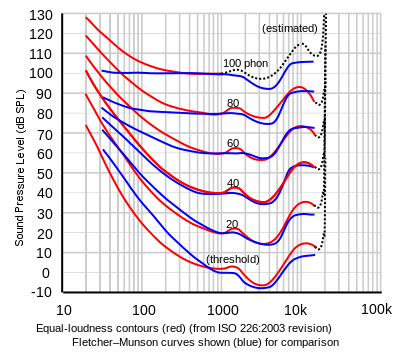19:
59:
report, the
Robinson-Dadson results were the odd one out, differing more from the current standard than did the Fletcher–Munson curves. It comments that it is fortunate that the 40-Phon Fletcher-Munson curve on which the
44:
used to refer to equal-loudness contours generally, even though the re-determination carried out by
Robinson and Dadson in 1956, became the basis for an ISO standard ISO 226 which was only revised recently.
84:
Subjects were not properly rested for days in advance or were exposed to loud noise in travelling to the tests which tensed the tensor timpani and stapedius muscles controlling low-frequency mechanical
56:
176:
67:
The article also comments on the large differences apparent in the low-frequency region, which remain unexplained. Possible explanations are:
166:
186:
78:
41:
211:
100:
52:
as the generic term, especially as a recent survey by ISO redefined the curves in a new standard, ISO 226:2003.
221:
49:
30:
120:
Robinson, D W; Dadson, R S (1956). "A re-determination of the equal-loudness relations for pure tones".
171:
81:
actually vary greatly in this respect (possible, and most recent determinations were by the
Japanese).
129:
201:
145:
206:
137:
133:
64:
standard was based turns out to have been in good agreement with modern determinations.
216:
195:
177:
Full
Revision of International Standards for Equal-Loudness Level Contours (ISO 226)
141:
95:
61:
181:
149:
34:
74:
The criteria used for judging equal loudness (which is tricky) differed.
18:
17:
37:, determined experimentally by D. W. Robinson and R. S. Dadson.
71:The equipment used was not properly calibrated.
187:Equal-loudness contours by Robinson and Dadson
40:Until recently, it was common to see the term
8:
182:Hearing curves and on-line hearing test
112:
172:Fletcher–Munson is not Robinson–Dadson
7:
122:British Journal of Applied Physics
14:
48:It is now better to use the term
128:(5). IOP Publishing: 166–181.
1:
238:
142:10.1088/0508-3443/7/5/302
101:ITU-R 468 noise weighting
29:are one of many sets of
50:equal-loudness contours
31:equal-loudness contours
27:Robinson–Dadson curves
22:
21:
134:1956BJAP....7..166R
23:
212:Audio engineering
55:According to the
229:
154:
153:
117:
237:
236:
232:
231:
230:
228:
227:
226:
222:Psychoacoustics
192:
191:
163:
158:
157:
119:
118:
114:
109:
92:
42:Fletcher–Munson
12:
11:
5:
235:
233:
225:
224:
219:
214:
209:
204:
194:
193:
190:
189:
184:
179:
174:
169:
162:
161:External links
159:
156:
155:
111:
110:
108:
105:
104:
103:
98:
91:
88:
87:
86:
82:
75:
72:
13:
10:
9:
6:
4:
3:
2:
234:
223:
220:
218:
215:
213:
210:
208:
205:
203:
200:
199:
197:
188:
185:
183:
180:
178:
175:
173:
170:
168:
165:
164:
160:
151:
147:
143:
139:
135:
131:
127:
123:
116:
113:
106:
102:
99:
97:
94:
93:
89:
83:
80:
76:
73:
70:
69:
68:
65:
63:
58:
53:
51:
46:
43:
38:
36:
32:
28:
20:
16:
167:ISO Standard
125:
121:
115:
66:
54:
47:
39:
26:
24:
15:
96:A-weighting
62:A-weighting
196:Categories
107:References
77:Different
202:Acoustics
150:0508-3443
85:coupling.
35:human ear
90:See also
33:for the
207:Hearing
130:Bibcode
148:
217:Sound
79:races
146:ISSN
25:The
138:doi
57:ISO
198::
144:.
136:.
124:.
152:.
140::
132::
126:7
Text is available under the Creative Commons Attribution-ShareAlike License. Additional terms may apply.
